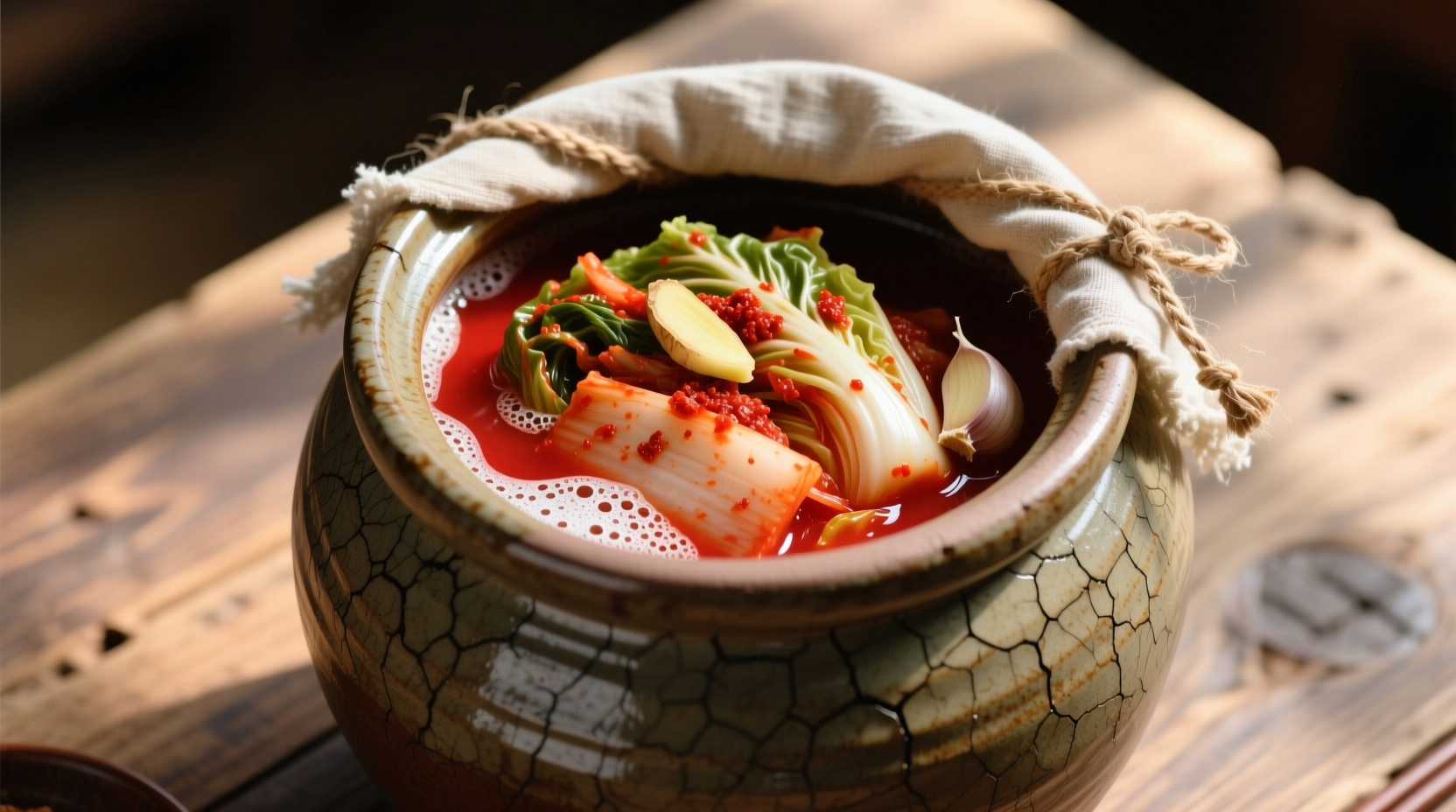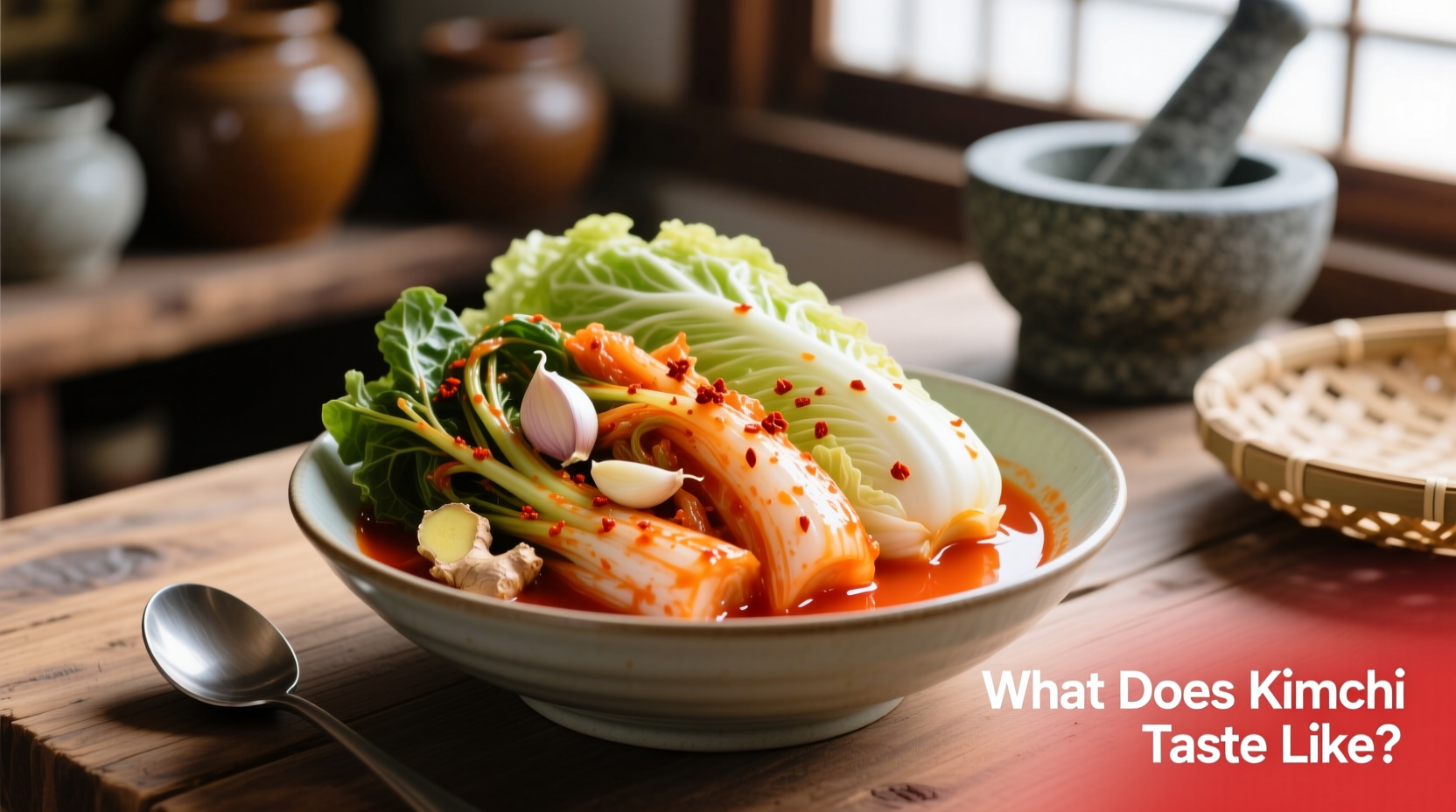The Essential Kimchi Flavor Experience
When you take your first bite of traditional napa cabbage kimchi (baechu kimchi), you'll immediately notice a vibrant symphony of flavors. The initial sensation is a gentle heat from Korean red pepper flakes (gochugaru), followed by a refreshing sourness from lactic acid fermentation. Underneath these dominant notes lies a deep umami richness from fermented seafood or fish sauce, with subtle sweetness balancing the ensemble. The crisp texture of properly fermented cabbage provides satisfying contrast to the spicy, tangy marinade.
What Creates Kimchi's Distinctive Taste?
Kimchi's unique flavor profile emerges from five key components working in harmony:
- Fermentation magic: Lactobacillus bacteria transform sugars into lactic acid, creating that signature tang
- Gochugaru (Korean chili flakes): Provides moderate heat with distinctive fruity, slightly smoky notes unlike other chili varieties
- Aromatic base: Garlic, ginger, and scallions contribute pungent depth that mellows during fermentation
- Umami boosters: Fish sauce, salted shrimp, or jeotgal add savory complexity without fishiness when properly fermented
- Vegetable foundation: Napa cabbage's mild sweetness and crisp texture balance the strong flavors

How Kimchi Flavor Changes Over Time
Understanding kimchi's evolving taste profile is crucial for appreciating this Korean staple. The fermentation timeline dramatically transforms its flavor characteristics:
| Fermentation Stage | Texture | Flavor Profile | Best Uses |
|---|---|---|---|
| Fresh (0-3 days) | Crisp, firm | Mildly spicy, vegetable-forward, subtle tang | As side dish with rice, in salads |
| Optimal (1-2 weeks) | Slightly softened but still crunchy | Balanced sour-spicy-umami, complex depth | Ideally eaten as banchan, in stews |
| Mature (3-4 weeks) | Softer, more yielding | Pronounced sourness, deeper umami, milder heat | Perfect for kimchi jjigae, fried rice |
| Well-aged (1+ months) | Very soft | Strongly sour, complex fermented notes, minimal heat | Cooking base, flavor enhancer |
Regional Variations in Kimchi Flavor Profiles
Not all kimchi tastes the same—Korean regions produce distinctive variations reflecting local ingredients and traditions. According to research from the Korean Food Research Institute, temperature and ingredient variations create dramatically different taste experiences:
- Northern (Pyongyang) style: Milder, less spicy, often includes more radish and less garlic—reflecting colder climate with shorter growing seasons
- Southern (Jeolla) style: Bolder, spicier, with generous amounts of garlic and fermented seafood—warmer climate allows for more robust fermentation
- White kimchi (Baek kimchi): No chili peppers, highlighting clean vegetable flavors with subtle sourness—traditional winter preparation
- Kkakdugi (radish kimchi): Crisp, refreshing with more pronounced sweetness and lighter fermentation notes
How Kimchi Compares to Other Fermented Foods
While often compared to sauerkraut, kimchi offers a distinctly different sensory experience. Unlike the one-dimensional sourness of sauerkraut, kimchi presents layered complexity. The addition of gochugaru creates a unique fruit-forward heat profile that differs significantly from the sharp vinegar bite of many Western fermented vegetables. As noted in a comprehensive study published in the Journal of Ethnic Foods, kimchi's flavor complexity stems from having 10-15 times more diverse microbial strains than typical sauerkraut, creating more nuanced flavor development.
What First-Time Eaters Should Expect
If you've never tried kimchi, anticipate these sensory elements:
- Initial aroma: Pungent but inviting—a blend of garlic, spice, and fermentation that becomes appetizing with exposure
- First bite sensation: Crisp texture followed by gradual heat build-up (less intense than raw chili peppers)
- Aftertaste: Refreshing sourness with lingering umami that cleanses the palate
- Temperature effect: Served cold, the flavors feel brighter; when cooked (as in kimchi stew), sweetness and umami deepen
Contextual Factors That Influence Kimchi Taste
Your kimchi experience may vary based on several important factors:
- Homemade vs. commercial: Artisanal versions often have more complex, nuanced flavors while store-bought maintains consistent but sometimes simplified profiles
- Seasonal variations: Winter kimchi tends to be milder (ferments slower in cold), summer versions often spicier to preserve better
- Ingredient quality: Freshly harvested napa cabbage versus off-season produce creates noticeable texture and flavor differences
- Serving temperature: Refrigerated kimchi delivers crisp freshness while slightly warmed kimchi reveals deeper umami notes
Developing a Taste for Kimchi
Many Western palates need adjustment to kimchi's bold profile. Food scientists at Seoul National University note that repeated exposure—just 7-10 small servings—typically creates flavor acceptance as your taste receptors adapt. Start with milder varieties like white kimchi or cucumber kimchi, gradually progressing to traditional baechu kimchi. Pairing with rice or neutral foods helps balance the intensity while your palate adjusts to the complex fermented flavors.











 浙公网安备
33010002000092号
浙公网安备
33010002000092号 浙B2-20120091-4
浙B2-20120091-4